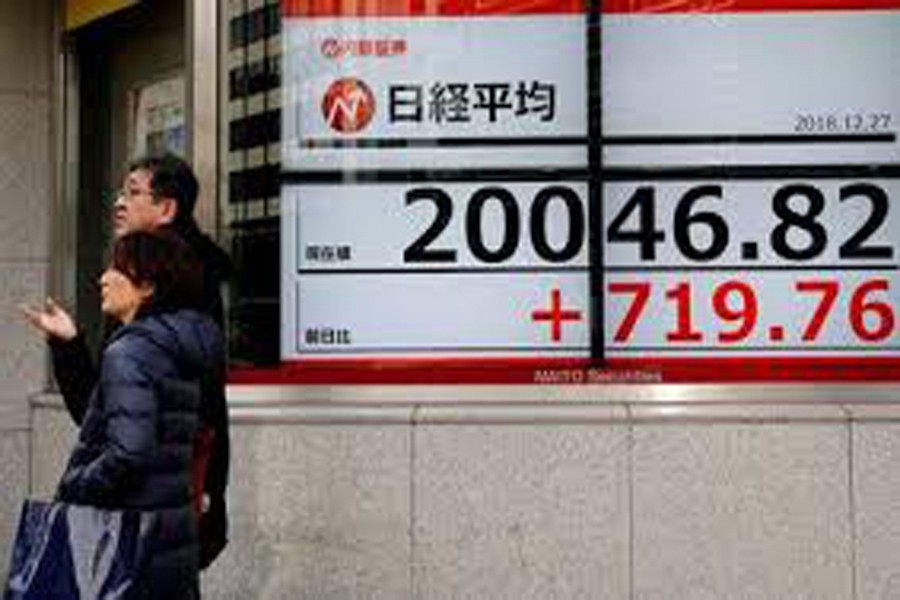Asian shares on Thursday rode a dramatic surge on Wall Street as markets, hammered by a recent drum roll of deepening political and economic gloom, cheered upbeat US data and the Trump administration’s effort to shore up investor confidence.
In a buying frenzy that was as spectacular as the recent rout, US stocks soared with the Dow Jones Industrial Average rocketing more than 1,000 points for the first time on Wednesday.
That helped push MSCI’s broadest index of Asia-Pacific shares outside Japan up 0.8 per cent and away from eight-week lows.
Japan’s Nikkei managed to pull out of bear market territory it had entered on Tuesday, surging 3.8 per cent.
Australian shares jumped 1.6 per cent as trading resumed after the Christmas break, while Chinese blue chips gained 0.6 per cent.
There was no single trigger for the overnight relief rally on Wall Street, though a Mastercard Inc report that sales during the US holiday shopping season rose the most in six years in 2018 helped allay concerns about the health of the US economy
There were also some attempts by the White House to temper its broadside against the Federal Reserve. Kevin Hassett, chairman of the White House Council of Economic Advisers, said on Wednesday that Fed Chairman Jerome Powell’s job was not in jeopardy.
His comments came days after President Donald Trump described the Fed as the “only problem” in the US economy after the central bank last week raised rates for the fourth time this year, and retained plans for more hikes in 2019.
A US government shutdown, concerns over slower global growth and US Treasury Secretary Steven Mnuchin convening a crisis group following the sharp sell-off in equities have also rattled investors.
“There is a question which is starting to unfold, whether this is a bear market rally or whether this is something more sustainable,” said Chris Weston, Melbourne-based head of research at foreign exchange brokerage Pepperstone.
“We probably got another 3 to 5 per cent in these market rallies before we see people looking to fade into this.”
Faced with deepening gloom, investors were quick to lap up media reports that a US trade team will travel to Beijing the week of January 7 to hold talks with Chinese officials.
“Investors are aware of negative factors, but they aren’t paying attention to those. They are looking at the Dow’s $1,000 gain,” said Norihiro Fujito, chief investment strategist at Mitsubishi UFJ Morgan Stanley Securities.
“I think worries regarding the U.S. government shutdown as well as lack of clarity over whether the U.S.-Sino negotiations (over trade) will go well or not still remain.”
Not all signs were positive overnight, with the Fed’s Bank of Richmond’s manufacturing index giving investors a reminder of the underlying global risks. The index fell the most on record, Refinitiv data going back to 1994 showed.
The weak figures rekindled fears that Sino-US trade tensions are weighing on US producers, and came days before the release of the Chicago purchasing managers index at the end of the week.
After the overnight rally, E-Mini futures for the S&P 500 were last down 0.3 per cent.
OIL JUMPS, DOLLAR SUPPORTED
Oil also caught investors’ attention after US crude and Brent overnight both marked their largest single-day rises since late November 2016.
US crude on Wednesday rallied almost 8.7 per cent, while Brent jumped more than 8.8 per cent in a partial rebound from steep losses that pushed crude benchmarks to lows not seen since last year.
US crude was last trading about half a per cent lower at $45.99 a barrel, while Brent gave up 0.4 per cent at $54.24 a barrel.
“If we can see oil prices moving up in the low end of the range, which is around $49 to $50, then we’ll continue to see equities moving higher,” said Pepperstone’s Weston.
As investors moved back into riskier assets overnight, 10-year US Treasury yields rose and last stood at 2.799 per cent, about 8 basis point off their lowest since April hit in Asian trading on Wednesday.
The shift into riskier assets provided support to the dollar, which rose nearly 1 per cent against the yen to 111.41 overnight - its largest single-day gain against the safe-haven Japanese currency since late April.
The dollar gave up some of those overnight gains on Thursday, and was last off 0.4 per cent at 110.95 yen, according to Reuters news agency.
The US currency was also on the back foot against the euro and the British pound, losing about 0.2 per cent against both currencies, to $1.1382 and $1.2658, respectively.
Against a basket of currencies, the dollar was down 0.2 per cent at 96.840.
In commodity markets, gold remained below a six-month peak hit during the previous session. Spot gold edged higher to $1,269.70, but its gains were capped as investors ventured back into riskier assets.


